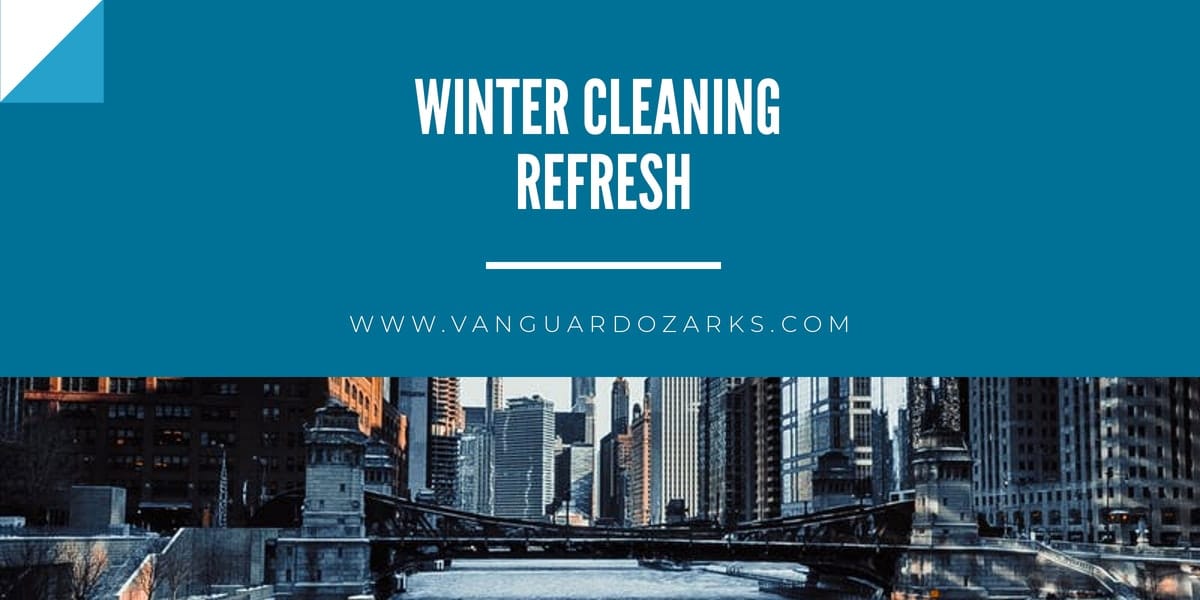With heavy snow and rainfall in the forecast for much of the Midwestern U.S. all Fall and Winter long, now is the perfect time to complete an office winter cleaning refresh and ensure the health, safety, and productivity of all building occupants.

Winter Cleaning for a Healthy Facility
Winter is here, and that means rain, snow, colds, the flu, and an enormous mess in your classrooms and offices.
Fortunately, it's not too late to start a winter cleaning maintenance program that will protect your facility and its occupants from the forces of nature and the constant battle with germs and bacteria.
Some of the critical areas to address are:
- Walkways, entryways, and lobbies.
- High-touch surfaces.
- Air duct cleaning and HVAC maintenance.
- Floors, carpet, tile, and grout, and;
- High dust.
Cleaning to Protect
A thorough deep cleaning and maintenance program protects your facility and its occupants from winter hazards, such as slips and falls, as well as increasingly deadly virus outbreaks.
Breaking down your facility into sections and identifying potential health and safety hazards is a good way to start.
Begin by assessing the entrance to your facility.
Slips and falls cost an average of 26 to 30 thousand dollars in general liability and worker's compensation claims.
To avoid this:
- If your facility is regularly exposed to icy walkways or snowfall, applying a combination of granular and liquid ice melt can ensure a safe path in and out of your facility.
- Additionally, it is advisable to remove standing water to avoid further hazards.
- Finally, make sure that the walkway is free of obstructions that may have been blown up by strong winds.
The next section is the entryway.
Placing walkway and entry mats at key locations will help prevent slips and falls, as well as protect your lobby floor and carpets.
Depending on the type of flooring in your facility, certain kinds of ice melt can cause significant damage and potentially lead to additional safety hazards.
- Sodium chloride ice melt leaves a white residue along the walkway if allowed to sit too long.
- Calcium chloride and magnesium chloride ice melts can damage the finish on wood floors, and leave an oily residue that presents a slip and fall hazard on smooth tile and flooring.
The next area in the facility to address is the carpets.
Carpets can hold several pounds of dirt, and snow on the bottom of occupant shoes can track in a lot of dirt, mud, toxic chemicals from the street, and numerous germs.
If allowed to build up, moisture can damage expensive carpeting, leaving an unprofessional appearance and additional expenses for repair and replacement.
Further, the combination of dirt, moisture, and whatever has been tracked in on the bottom of occupant shoes can result in the buildup of mildew and bacteria, creating a health and safety issue that could potentially lead to illness, time off of work, missed school days, and costly medical bills.
Additionally, a commonly missed area regarding floor cleaning and maintenance is grout, especially in bathrooms.
Grout, unless it has recently been coated with sealant, is porous and has been shown to house numerous disease-causing bacteria, including:
- Salmonella.
- Streptococcus.
- Staphylococcus.
- E.coli, and;
- Campylobacter.
Finally, you'll want to identify high-touch points where germs accumulate and quickly spread to building occupants, resulting in illness and severe declines in productivity.
The most common areas are found in:
- Areas along the main point of entry, including door handles, rails, and elevator buttons.
- Pretty much everything in the restroom and breakroom.
- Office computer equipment, phones, and printers, and;
- Vending machine and water fountain buttons.
Deep cleaning these areas regularly is highly advisable, but to get the real benefit of infection prevention, high-touch surfaces should be disinfected every day throughout the cold and flu season.
Cleaning for Health
Conventional commercial cleaning products release toxic chemicals into the air, contribute to illness, and have been connected to outbreaks in asthma attacks and asthma-like symptoms, especially among young children in classrooms.
High dust from ceiling fans, light fixtures, and air ducts can also contribute to respiratory and other acute health issues, such as headaches, itchy eyes, and sore throats--all of which compromise occupant productivity and cognitive output.
Further, influenza and other viruses can spread from person to person through the air.
While there is little that can be done to avoid this in tight quarters, common in classrooms and offices with cubicles, increasing the airflow, adjusting the temperature, and installing HEPA air filtration systems can improve indoor air quality and reduce the overall occupant exposure to dust particles, bacteria, and several kinds of viruses.
References & Resources
Takeaway
Spring isn't the only time for initiating vital cleaning and maintenance programs that protect your facility and its occupants.
Further, winter may be the perfect time to implement a new cleaning for health program to ensure the health and safety of all facility occupants against the hazards of toxic commercial cleaning products and a lack of external ventilation.
Many of the areas we have discussed should only be serviced by experienced service providers with the proper equipment and training to avoid damaging your facility or contributing to health and safety issues.
Outsourcing is a proven method for cost-effectively implementing these maintenance programs without the cost and overhead of recruiting, hiring, and training an in-house custodian.
Contact us today and discover why Vanguard Cleaning Systems® is the Standard of Clean® for businesses throughout Northwest Arkansas, Missouri, and Oklahoma.
In Oklahoma, dial 918-960-4450
In Arkansas, dial 479-717-2410
In Missouri, dial 417-812-9777
